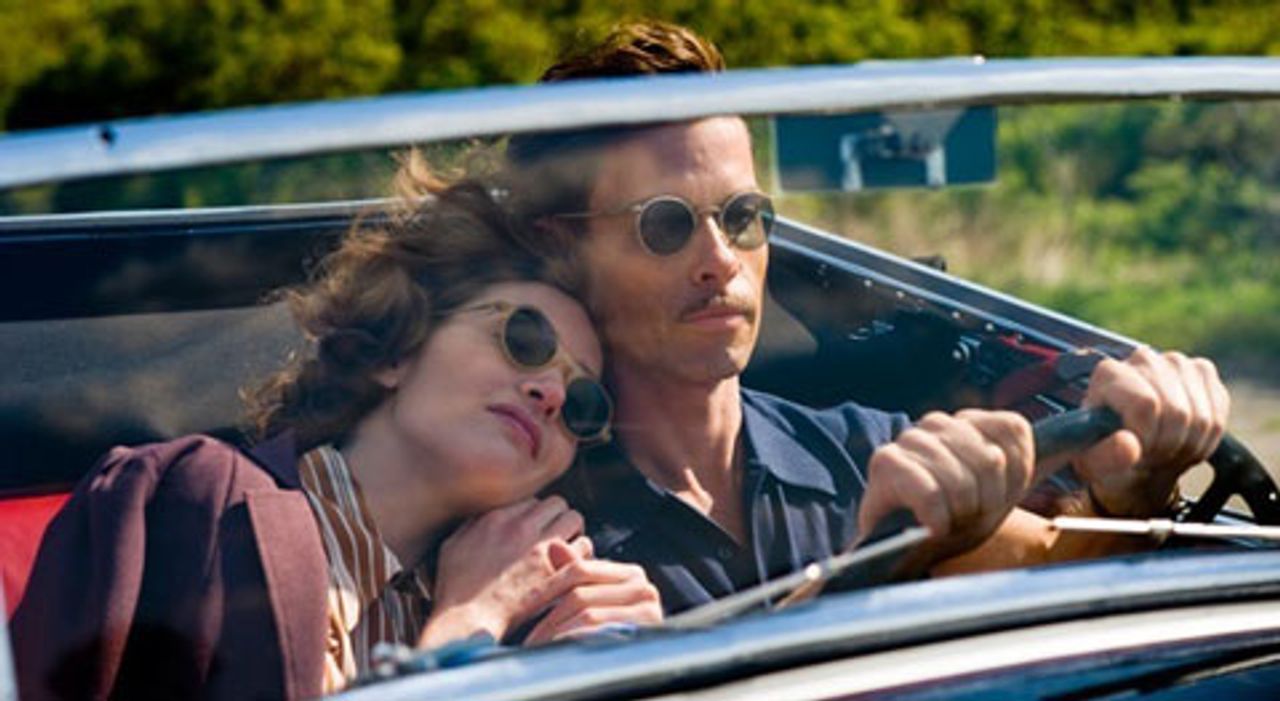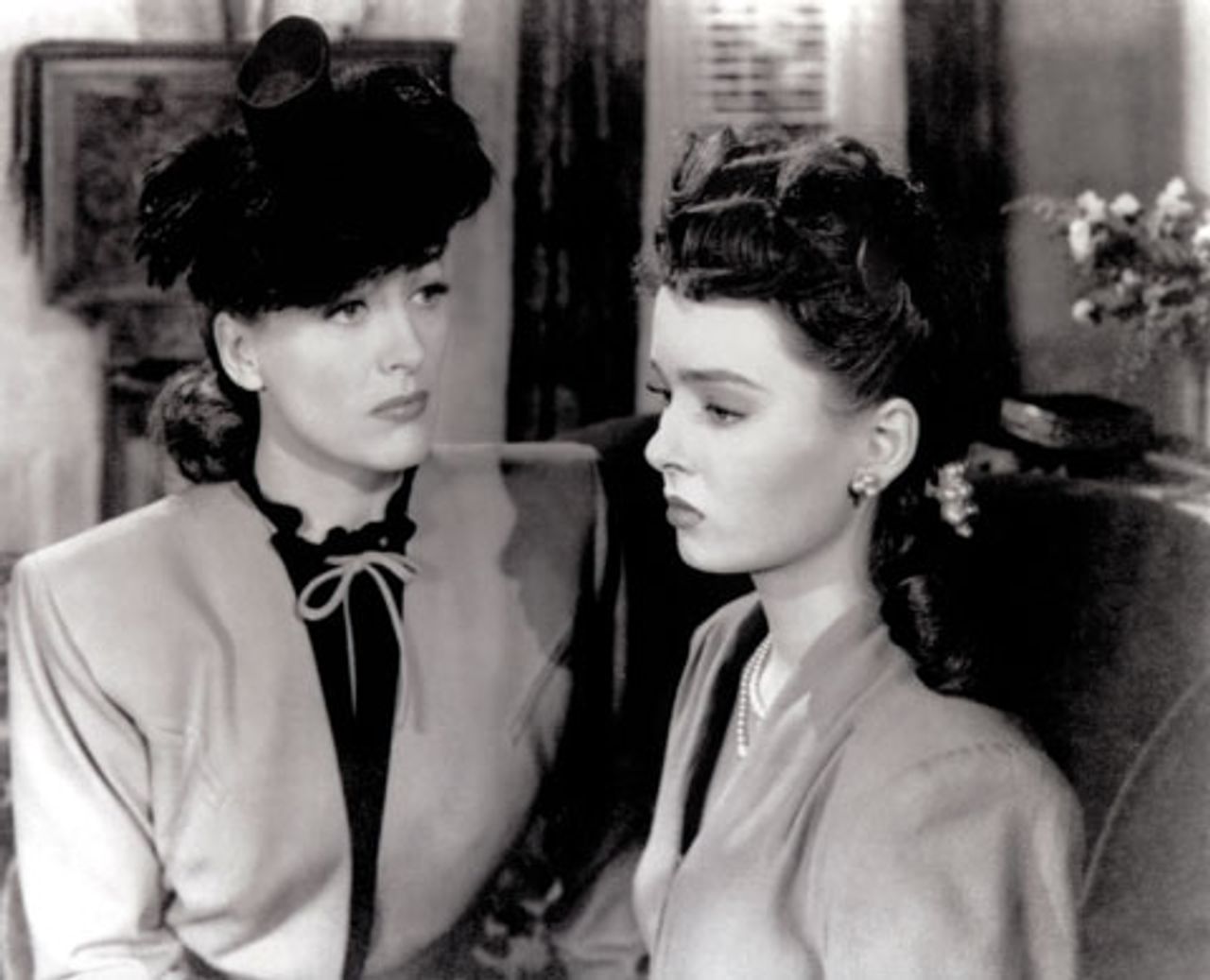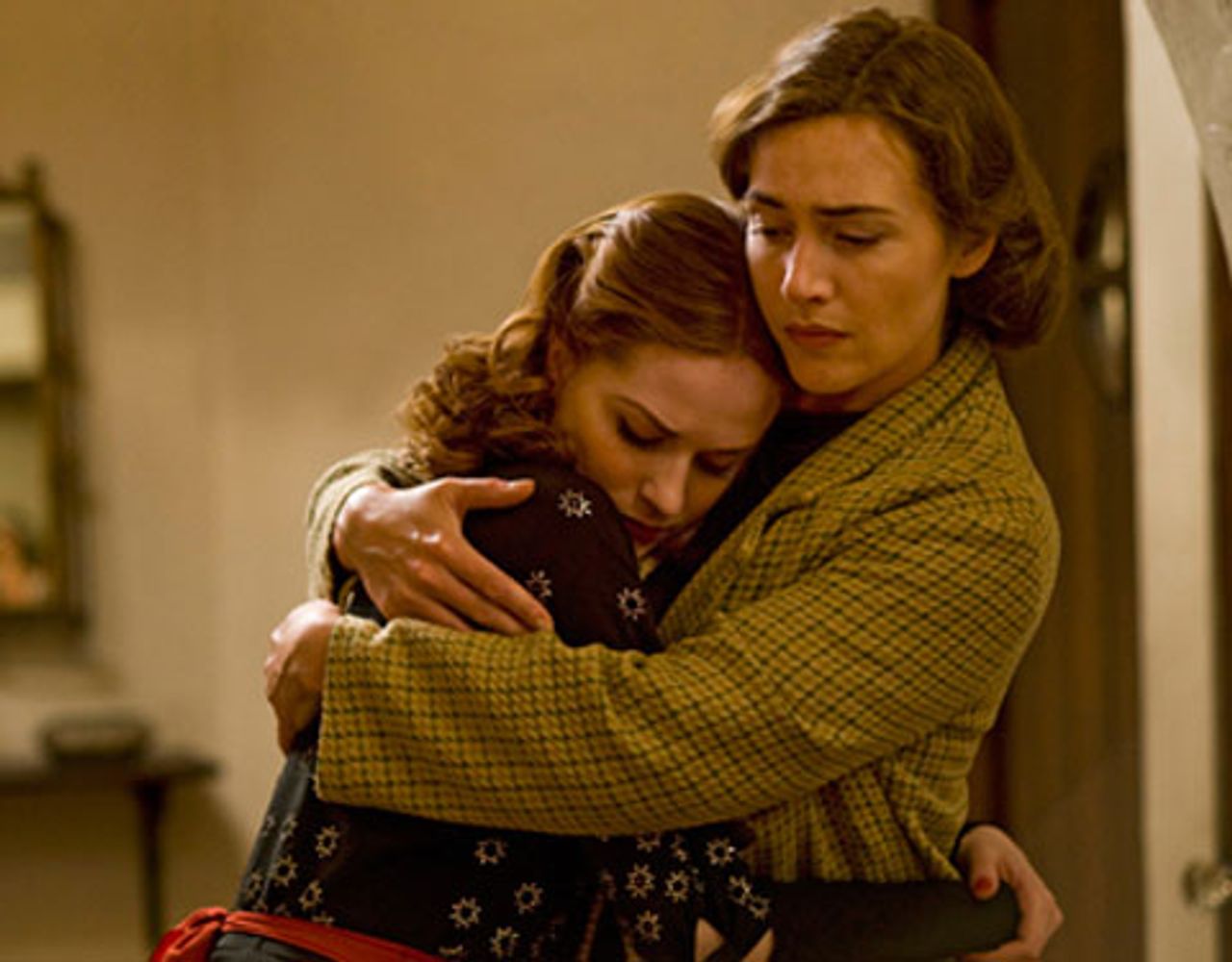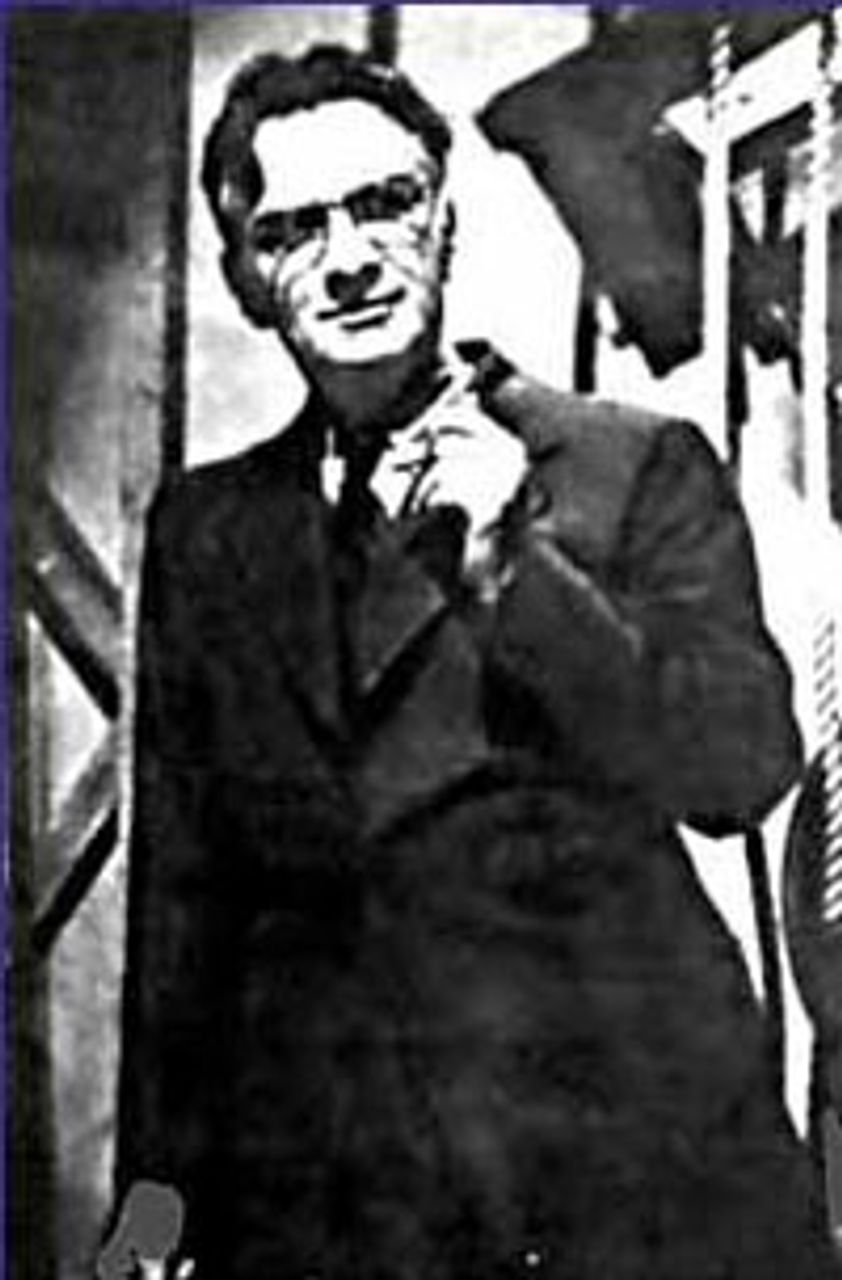Directed and written by Todd Haynes; co-written by Jon Raymond; based on the novel by James M. Cain
The HBO five-part miniseries Mildred Pierce, directed by independent filmmaker Todd Haynes and based on the 1941 novel by American author James M. Cain (1892-1977), is a serious and commendable effort, a highly uncommon attempt—in our day—to root people’s lives and psychology in a realistic economic and social context. One can only hope Haynes’s drama heralds the return of deeper and more probing examinations of social life to American filmmaking and television.
 Mildred Pierce
Mildred Pierce“I make no conscious effort to be tough, or hard-boiled, or grim,” Cain (The Postman Always Rings Twice, Serenade, Mildred Pierce, Double Indemnity) once noted of his own writing, “or any of the things I am usually called. I merely try to write as the character would write, and I never forget that the average man, from the fields, the streets, the bars, the offices, and even the gutters of his country, has acquired a vividness of speech that goes beyond anything I could invent, and that if I stick to this heritage, this logos of the American countryside, I shall attain a maximum of effectiveness with very little effort.”
 Curtiz's 1945 version of Mildred Pierce
Curtiz's 1945 version of Mildred PierceIn the remarkable 1945 film adaptation directed by Hungarian-born Michael Curtiz (from a script worked on by numerous screenwriters, including William Faulkner and future blacklist victim Albert Maltz, and starring Joan Crawford, Zachary Scott and Jack Carson), Mildred Pierce’s timeframe was shifted to the post-Depression years. The treatment of the revised narrative changed mood too, to that of a stylish film noir. Haynes has chosen to adhere more faithfully to the original book, which helps account for its more than five hours in length.
In so doing, Haynes has effectively created a “logos of the American countryside.” The film is unusual as well in its meticulous and straightforward story-telling. This Mildred Pierce begins in 1931 in southern California on the eve of the election of Franklin D. Roosevelt and works its way through to the onset of World War II, taking its time with the progression of events and characters.
A striking facet of Haynes’s series is its obvious concern to bring back many of the hard facts of American life—economics, business and cash relations in particular—to the study of people’s psychology and behavior. This is something that has largely been lost in recent film and literature, and its loss helps account for the appalling superficiality of a large number of today’s filmmakers.
 Mildred Pierce
Mildred PierceWhen the series opens, Mildred Pierce (Kate Winslet) lives in a modest Spanish-style bungalow in Glendale, California, a Los Angeles suburb, with two young daughters. The Depression has hit her family hard. Her marriage is failing, due in no small measure to the collapse of the real estate development firm owned by her husband Bert (Brian F. O’Byrne). Unemployment has token a toll on his ego, and he seeks solace in the arms of a Mrs. Biederhof (described by Cain as “a lady of uncertain years, with a small income from hovels she rented to Mexicans”).
When Mildred throws Bert out, friend and neighbor Lucy Gessler (Melissa Leo) defines her new standing: “Well, you’ve joined the biggest army on earth. You’re the great American institution that never gets mentioned on the Fourth of July—a grass widow [a wife abandoned by her husband] with two small children to support.”
Haynes pays close attention to the financial conditions of his characters and their consequences. With Bert out of the picture, his former business partner Wally Burgan (James LeGros) shows an interest in Mildred. Neighbor Lucy advises Mildred to make him dinner rather than accept an invitation to dine out. Better that she be owed than that she owe—also better to marry for security than love.
Wally is not a sure thing, so Mildred pounds the pavement in search of work. She quickly learns there are scores of women with better skills who are unemployed. When she initially expresses revulsion at waiting tables, she is told by a headhunter that an empty belly trumps pride. Despite her poverty, she is frightened that her status-obsessed daughter Veda (first played by Morgan Turner and later by Evan Rachel Wood) will reject her for wearing a uniform and mopping up crumbs. Mildred saves her pennies from hash-slinging and pie-making, at which she excels, in order to open her own business. Securing the property for her restaurant necessitates making a cold-hearted legal break from Bert.
As the result of unrelenting effort, Mildred starts to know some success. Monty Beragon (Guy Pearce), of the aristocratic Beragons from Pasadena, enters her life. Haynes highlights the sexuality of the liaison to draw attention to Mildred’s emotional starvation. Monty ignites in her a hunger that she has suppressed in the process of pursuing financial advancement.
After the sudden death of her younger and more appealing daughter Ray, Mildred is guilty over the relief she feels that it was not her precious Veda who died. The tragic event clears the way for Mildred to focus on the surviving child who “has something inside her that I thought I had.”
As the embodiment of the aspirations of the middle class for upward mobility, Veda is also the distillation of Mildred’s fantasies and illusions. Being penniless does not stop the determined mother from buying Veda’s piano lessons and expensive clothing. She comes from the social milieu that most ferociously believes in the American Dream.
The mother-daughter relationship is a focal point of the story. Mildred yearns for Veda’s affection, withering under her contempt and snobbery, and consecrates her life to the ungrateful girl. This, despite the fact Veda is a counterfeit compared to the lovable and loving, and now deceased, Ray.
Glendale and Pasadena are the two poles between which the story unfolds in Mildred Pierce—home, respectively, to working class or lower middle class families, on the one hand, and old, distinguished money, on the other. Although Monty’s family has lost its fortune, he still looks down on Mildred even as he becomes her “paid gigolo.” Mildred’s restaurants are her “Holy Grail,” attained through monumental effort and sacrifice; for Monty and Veda, they are condescendingly called “pie wagons.”
Monty and Veda join forces against Mildred, and, as Cain puts it, Monty grants to Mildred’s daughter “all the social equality he withheld from Mildred.” Haynes is successful in dramatizing the complexities of this triangle. Nonetheless, as Mildred makes clear, “The hand that holds the money cracks the whip.”
Veda claims she is only emulating Mildred in using men to get what she wants. While Mildred has a genuine concern for people even when her motives are impure, Veda’s machinations are grotesque and sociopathic. She can, with icy sangfroid, fake a pregnancy to extort money from a high-society family.
In a chilling rant directed at her mother, Veda gets to the heart of the matter: “With this money I can get away from you. From you and your chickens and your pies and your kitchens and everything that smells of grease. I can get away from this shack with its cheap furniture, and this town and its dollar days, and its women that wear uniforms and its men that wear overalls.”
When Veda (rather arbitrarily) proves to possess a “miracle voice”—a one-in-a-million vocal instrument, radio sponsors descend upon her with offers of lucrative contracts. She is mentored and promoted by an Italian impresario, who views her as a exceptional coloratura, but a vile human being. At this point, Mildred and Veda are estranged. To remedy this, Mildred seeks out Monty who is “between cars,” meaning, in a financial hole. She purchases the Beragon mansion in Pasadena for a princely sum. Monty and a Pasadena address are the bait for Mildred to reel in Veda, with ultimately disastrous results.
The cash Mildred lavishes on her daughter in return for a smattering of attention lands her in the clutches of bankers and creditors who have hired Wally to represent their interests. The scene featuring the unvindictive, but unforgiving money lenders is one of the film’s best. Wally is not essentially Machiavellian, he simply does not want to be brought down with Mildred.
With its somber-hued cinematography and inclusion of historical details, such as a portion of Roosevelt’s first inaugural address, Haynes’s Mildred Pierce makes an effort to evoke the desperate times. Winslet’s performance, particularly the increasing weariness in her face, expresses the stress and insecurity that took hold of the population in that period. LeGros as big-bellied Wally, a quasi-bottom-feeder, is convincing, and Pearce’s Monty strikes the perfect chord as a nonchalant cynic.
Haynes has striven, with considerable success, to convey what Cain, a sharp writer and a fascinating figure, was driving at in his novel.
 James M. Cain
James M. CainCain—born and raised in Annapolis, Maryland, and a college graduate while still a teenager—fought in World War I and drifted through various white-collar jobs before becoming an associate of H.L. Mencken and a major contributor to the latter’s American Mercury. Moving to New York, he became a protégé of journalist Walter Lippmann and a lead editorial writer on the New York World, and served for a brief time as the managing editor (under Harold Ross) of the New Yorker magazine.
Cain later migrated to southern California and tried, for the most part unsuccessfully, for over a decade in the 1930s and 1940s to write for films. Meanwhile, several of his own novels, with scripts written by others, were adapted famously and successfully for the screen. Cain became something of an expert on what was the seamy reality of life in California for a good portion of the population, especially those prone to self-delusion. Critic David Madden noted that Cain “was interested in the way the high hopes of the westward movement collapsed on the Pacific shore in the vacant glare of a sunlight that gilds the cheapest artifacts of transient American technology.”
Novelist James T. Farrell suggested that “Cain is between the serious and tragic work by men like [Theodore] Dreiser and the popular writers. A master at playing between both sides…he is a literary thrill producer who profits by the reaction against the sentimentality of the other years and, at the same time, gains from the prestige of more serious and exploratory writing.”
The distinguished literary critic Edmund Wilson was one of the first to devote serious consideration to Cain, in his 1940 essay, “The Boys in the Back Room,” dedicated to a number of gritty American novelists. Wilson considered Cain and his school to have been strongly influenced by Ernest Hemingway. Written prior to the publication of Mildred Pierce, Wilson’s essay addresses itself to Cain’s heroes, “always treading the edge of a precipice; and they are doomed.” Wilson notes that Cain’s protagonists’ fate “is forecast from the beginning, but in the meantime he has fabulous adventures—samples, as it were, from a Thousand and One Nights on the screwy California coast.”
Cain is one of the “poets of the tabloid murder,” observes Wilson (although, ironically, when Hollywood adapted Mildred Pierce, it was obliged to add such a crime). “Such a subject might provide a great novel: in An American Tragedy, such a subject did.” But, in Cain, the critic complained, we too often run up against “the wooden old conventions of Hollywood.” Mildred Pierce, in fact, avoids some of those conventions, but Wilson’s comments on Cain’s limitations are fundamentally just. After the Second World War, the novelist produced relatively little of value.
At any rate, at the time of writing Mildred Pierce, Cain had a decidedly “knowing” quality about life in America and of its lower classes, who are not subjectively monstrous, even when they do monstrous things, but are impelled to act for reasons fundamentally beyond their control.
The most high-born and “high-minded,” Monty and Veda, are the most treacherous. They are emotional exploiters who don’t want to dirty their hands with work, but are perfectly happy to live off the hard labor of others.
Haynes understands this. In his direction of Winslet, he allows the audience to concentrate on a face that emphasizes how hard she works and how tenacious she is. And despite that, she loses everything she thought was important. Mildred epitomizes how hard Americans work in general, often on the basis of illusory notions of what they are going to get out of it. Or, as she says, “to be something before I die.” There are millions like her, who work themselves to the bone, imagining that they are their “own boss,” when their fates are almost entirely determined behind their backs by global events and big moneyed interests.
Todd Haynes is an intriguing director, who has certain insights into American society and is not fooled by its official defenders and various false saviors. His movies, such as Safe (1995) about a housewife afflicted with “20th century disease”—in fact, a variety of middle class, suburban anxiety and disorientation—and Far From Heaven (2002), a saga set in the 1950s focused on racial tension and hypocrisy in suburban Connecticut, are clearly influenced by figures such as Rainer Werner Fassbinder and Douglas Sirk.
Haynes’s Mildred Pierce is reminiscent of an earlier period when American writers and filmmakers knew something. Unlike the majority of their counterparts today, they did not approach the details of life carelessly and superficially. Artists whose illusions were knocked out of them by the Depression and its mass suffering learnt something about the brutality of American capitalism.
The fact that Haynes is taking an unusual path is confirmed in interviews where he reveals his motivation for making Mildred Pierce: “I’m a great admirer of Michael Curtiz’ original film, but I was so startled and surprised by reading the James M. Cain novel, which I had never read until 2008, right as the markets were tumbling in the United States…. The novel is intensely relevant. I love how it links potential pathologies in maternal desire with potential excesses in middle-class yearning.”
He felt it important “to have an experience where you actually move through someone’s life without leaping hysterically, flashing forward, and jumping around. I’ve never done anything this doggedly linear in my career as a filmmaker, and that’s what the novel does—it spans nine years.”
It should be mentioned that the 1945 Curtiz film has an undeniable ease and fluidity with class and social concepts. The Haynes project is a bit less organic on this score (as he himself points out). When filmmakers start on this road, one that was once traveled by their talented forebears, a certain awkwardness and stiffness should be expected. Nonetheless, Haynes’s Mildred Pierce stands out for insisting that economic realities are the bases of bases.
